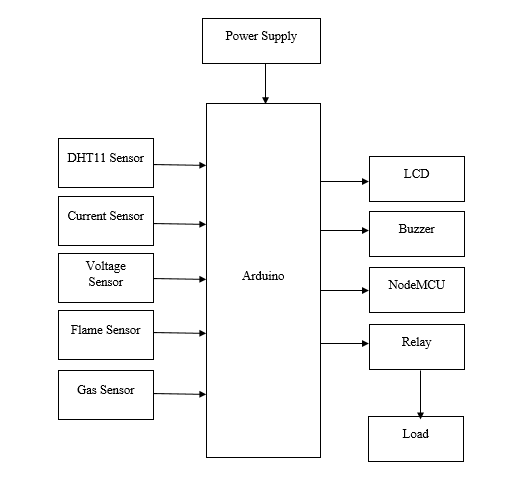Automatic Industrial Fault Detection and IoT based Remote Monitoring
Objective
The main objective of this project is to design an automatic industrial fault detection system with IoT-based remote monitoring capabilities, enabling identification of faults and monitoring of industrial processes for improved efficiency and maintenance.
Abstract
This project focuses on the design and implementation of an Arduino-based system that interfaces with various sensors and modules to detect harmful gases, flames, measure temperature and humidity, as well as monitor current and voltage levels. The system incorporates a gas sensor, flame sensor, DHT11 sensor, current and voltage sensors, a buzzer, an LCD display, and a relay to achieve monitoring and provide timely feedback. The gas sensor is employed to detect the presence of harmful gases in the environment. The flame sensor, on the other hand, detects flames by sensing the infrared light emitted by them, thus enabling the system to respond promptly to fire hazards.
The DHT11 sensor is utilized to measure temperature and humidity levels in the surrounding environment. This data is valuable in assessing comfort levels and determining if any adjustments are necessary. To monitor electrical parameters, such as current and voltage, current and voltage sensors are integrated into the system. These sensors enable the Arduino to measure and track these parameters, providing essential information for load management and safety purposes.
In order to provide audio feedback, a buzzer is incorporated into the system. The buzzer emits sound alerts or warnings when hazardous conditions are detected, enhancing situational awareness. Additionally, an LCD display is employed to provide visual feedback by presenting information regarding the detected gas levels, flame status, and environmental conditions. To ensure safety, a relay is used to control the load. The relay is designed to automatically shut down the load if the current exceeds a predefined threshold. This protects the system from potential damage due to excessive electrical current.
Keywords: Arduino Controller, Flame sensor, Gas sensor, DHT11 sensor, LCD, NodeMCU, Current sensor, Voltage sensor
NOTE: Without the concern of our team, please don't submit to the college. This Abstract varies based on student requirements.
Block Diagram

Specifications
Hardware Requirements:
- Arduino UNO
- Voltage sensor
- Current sensor
- DHT11
- Gas sensor
- Flame sensor
- Buzzer
- Power Supply
- Relay
- LCD
Software Requirements:
- Arduino IDE
- Embedded C
Learning Outcomes
- Arduino pin diagram and architecture
- How to install Arduino IDE software
- Setting up and installation procedure for Arduino
- Introduction to Arduino IDE
- Basic coding in Arduino IDE
- Working of LCD
- Interface LCD with Arduino
- Working of power supply
- About Project Development Life Cycle
- Planning and Requirement Gathering (software’s, Tools, Hardware components, etc.,)
- Schematic preparation
- Code development and debugging
- Hardware development and debugging
- Development of the Project and Output testing
- Practical exposure to
- Hardware and software tools.
- Solution providing for real time problems.
- Working with team individual.
- Work on Creative ideas.
- Project development Skills
- Problem analyzing skills
- Problem solving skills
- Creativity and imaginary skills
- Programming skills
- Deployment
- Testing skills
- Debugging skills
- Project presentation skills





 Paper Publishing
Paper Publishing

